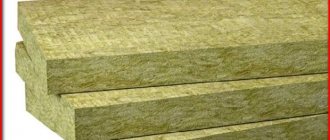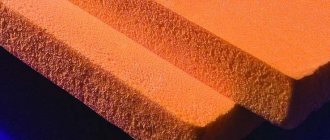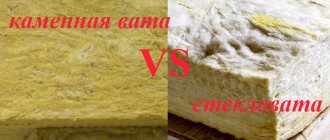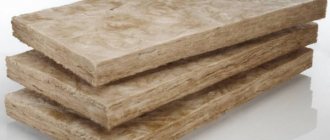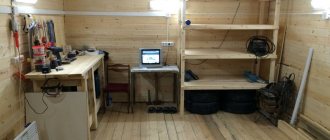Various types of insulation materials are used in the construction industry. They have their own characteristics, characteristics and installation technology. Among them, new generation building insulation materials are gaining the most popularity. These include expanded polystyrene, mineral wool and penoplex. The well-known glass wool does not give up its position and is successfully used in the construction of industrial premises and residential buildings.
Glass wool is used in various types of house construction, does not require special skills for installation and has excellent thermal insulation and sound insulation qualities. It is a universal insulation material and has high strength, elasticity and resistance to vibration. Glass wool is necessary for external and internal work, when installing pitched roofs and insulating horizontal surfaces. It can be used to seal gaps and cracks in walls. Glass wool is available in different forms - rolls or slabs. Many experts successfully use the material in practice, but do not even take into account the harmful properties of glass wool.
Why is glass wool dangerous for humans?
As mentioned above, glass wool has a fibrous structure and consists of tiny microparticles, which are held together by formaldehyde resins. When these resins break down, they release phenol into the air, which is considered a strong poison. Fibrous structure of glass wool
Inhalation of even small doses of phenol can cause poisoning of the body and lead to diseases of the central nervous system. Phenol emissions are especially dangerous in hot summer weather and in a warm room.
European Union scientists conducted research to study the properties of glass wool. According to their results, some varieties of this popular insulation are classified as the second hazard group; they contain carcinogenic substances. Solid resin content within 4% is considered safe for the human body.
What is known about insulation material
Externally, glass wool is similar to stone and slag wool. All three are varieties of mineral wool. Let's talk in more detail about each:
- When producing the stone type of insulation, rocks, usually basalt, are used.
- Stone is made from industrial waste called slag.
- Glass wool is produced from waste from glass production. The material is usually made from broken glass.
During production, raw materials are crushed and melted. During the process, the material is enriched with various additives. The result is a special material similar in consistency to cotton wool.
Insulation can be used at different temperature conditions. The negative point is the presence of causticity. The product consists of many fibers of different diameters and lengths. The raw materials do not burn, but they are no different in vibration resistance. The material reliably protects from frost without letting heat out.
Phenol is a health hazard
With chronic poisoning by poisonous phenol, a person begins to lose weight, diarrhea appears, heaviness when swallowing, saliva is released profusely, dizziness occurs, and urine becomes dark.
If a person has been under the influence of phenol for a long time and has inhaled its vapors, he may feel weakness and muscle pain; upon examination, an enlarged liver is detected. Nervous disorders are observed, accompanied by severe headaches, even leading to loss of consciousness.
In ordinary residential premises, about 40 kg of dust, consisting of mineral particles of different diameters, is formed during the year. Small ones, with a diameter of less than 5 microns, are in the air. It is these particles that are considered allergenic, which, when inhaled, penetrate into a person’s lungs and, accumulating there, pose a threat to the respiratory system.
Most mineral dust particles are of a dangerous size - less than 3 - 5 microns; they settle in the lungs along with toxic phenol vapors.
Please note: for this reason, it is very important to constantly ventilate the living space.
Instructions for insulating the roof from the inside
Next, we’ll look at how to properly insulate a roof. For ease of perception of information, we will divide the procedure into 3 stages. As an example, consider laying basalt wool. Our choice fell on this material, since its installation is more difficult than penoplex (or its analogues).
Stage 1: preparing materials tools
To complete the work you will need the following list of tools (purchase the missing ones):
- Screwdriver (or small hand drill).
- Tape measure, level, pencil - this will be needed for marking.
- Construction ladder. In its absence, you can build scaffolding from unnecessary boards.
- Gasoline or electric saw. You can replace it with a grinder with a wood disc or a circular saw.
- Construction stapler with staples (type 54).
- Personal protective equipment: gloves, respirator.
We also purchase the following list of materials:
- Basalt wool.
- Vapor barrier film.
- Thermal protection membrane.
- Slats for creating sheathing. The thickness should be approximately (plus or minus 1 cm) the same as that of the insulation.
- Self-tapping screws for fastening slats (50-60 mm).
Isover brand vapor barrier film
Stage 2: processing of floors and preparation of sheathing
Before insulating the roof, it is necessary to prepare the original surface. You will need to do the following:
- Check the ceilings for integrity (relevant if the roof was built several years ago). If there are boards with breaks, cracks or a large number of fallen knots, they must be replaced.
- Using a level, check that the guide boards are installed evenly. Adjust if necessary.
- Treat all wooden surfaces with an antiseptic. Any protective impregnation for wood will do. This is an optional procedure, however, it will significantly increase the operational period of the floors.
- Place slats along the rafters (i.e. perpendicular to them) to create a sheathing. The distance between them should be 2-3 cm less than the width of the purchased insulation (usually it is 60 or 100 cm). It is also advisable to treat reiki with an antiseptic.
What the sheathing should look like
Stage 3: laying thermal insulation
- To ensure that the insulation of the attic roof from the inside is as effective as possible, the first step is to install a moisture-proof film on the roofing. It is attached “overlapping” using a stapler.
- The joints are taped with construction tape. This measure is necessary to create a tightness - this is the only way to reliably protect the insulation from environmental influences.
- Thermal insulation is placed in the gap between the guides. It is also attached using a butt-to-butt stapler. When cutting, you must leave a margin of 1-2 cm on each side. This is necessary so that the cotton wool fills the entire space as tightly as possible.
- At the end, a heat-protective membrane is attached to the brackets on top of the insulation. The heat-reflecting layer should be directed indoors.
The process of laying insulation
Important: even the slightest cracks should not be allowed when laying insulation, as “cold bridges” will begin to form in them and moisture will enter, significantly reducing the technical characteristics. At this point, the insulation of the roof from the inside with your own hands is completed, you can begin finishing the floors
As you can see, this procedure is not particularly complicated, so with patience, it can be done without the help of specialists
At this point, the insulation of the roof from the inside with your own hands is completed, you can begin finishing the floors. As you can see, this procedure is not particularly complicated, so with patience, it can be done without the help of specialists.
Harm of glass wool to the lungs
The health hazard from glass wool is characterized by the fact that the composition contains mineral particles and phenol resins, which are added to hold these particles together. Small particles of glass wool can enter the human lungs
If glass wool is used in an enclosed area, particles and toxic phenol are released into the air, which are inhaled by the lungs of people present there.
Harmful microparticles are not removed from the lungs for a long time, and can cause:
- allergic reaction in the form of a dry cough;
- shortness of breath;
- respiratory diseases that become chronic.
It's a fact: people who deal with glass wool are at risk for lung cancer.
Pulmonologist D. Vinogradov, associate professor of the 1st Moscow State Medical University named after. Sechenov notes that microparticles can cause various dermatoses, chronic and obstructive bronchitis, against this background there is the possibility of developing bacterial and fungal infections.
You need to know: indoor plants help bind mineral dust. Carpets and all sorts of soft toys are dust collectors. When cleaning a room with glass wool insulation elements, it is recommended to use a washing vacuum cleaner or install an air humidifier in the room.
Dependence on the density of the material and the location of insulation
A material with a certain density has a specific purpose. Thus, basalt insulation with a density of 25-30 kg/m3 is intended for thermal insulation of floors. He should not experience any stress on himself. 35 kg/m3 is used for the roof, 45 kg/m3 can be installed vertically. Materials with a density of 50-60 kg/m3 are used in layered installation, and 70-80 kg/m3 are installed in ventilated facades.
For plaster facades it is necessary to purchase slabs with a density of 140-150 kg/m3, and for flat roofs with a load - 160-180 kg/m3.
When choosing a material, you should take into account that the denser the insulation, the higher its price, since more raw materials were spent for production. But at the same time they have the same thermal characteristics.
https://youtube.com/watch?v=4MLsqSnjaw8%3F
Harm of glass wool to the skin
During direct contact of glass wool with human skin, when laying it they work without gloves or special clothing, sharp fragments of microparticles penetrate inside and cause skin irritation, at the site of contact it becomes red and itching appears.
The particles can damage the skin and penetrate deep into the dermis, causing allergies. You should refrain from scratching the affected areas. Glass wool should be removed under clean running water.
This is important: all repair work with glass wool must be carried out while wearing protective clothing and rubber gloves or tarpaulin mittens.
How to work with fiberglass
Experts offer some tips for working with fiberglass that will help protect your health.
For example:
- When working, use disposable special clothing with a hood;
- Wear safety glasses;
- Cover your hair with a hat or cap;
- Make sure that your hands do not come into contact with the material; use mittens or gloves;
- If the material is loose, work in a cotton-gauze bandage;
- If glass wool gets on an open area of skin, take a shower to wash off all the microparticles;
- Do not try to wash your work clothes; if there is a need for cleaning, shake off the dust vigorously.
But the most important thing, in the event of an injury, is to go to a medical facility, since it is almost impossible to alleviate the situation at home. The harmfulness of staple fiber is obvious. The danger can be anything from itching, bronchitis (if inhaled) and the big list ends with body allergies. How dangerous cotton wool is and what to do to get rid of the consequences can be found out in a special video. How to work in such conditions, how to cleanse the skin of small particles, whether it will be enough to simply wash yourself, and what to eat if poisoned, you can learn all this in video format.
Harm to the eyes
As is known, glass wool is characterized by increased fragility. Sharp and fine microparticle fragments penetrate the eyes and can cause serious eye damage. During repair work using glass wool without special glasses, particles can get into your eyes.
Symptoms of exposure:
- sharp pain in the eyes;
- lacrimation;
- feeling of discomfort;
- increased pain.
What to do if glass wool dust gets into your eyes? In this case, if you experience discomfort, you should consult a doctor.
Product types
The range of thermal insulation products using glass wool includes: soft mats and slabs, semi-rigid and rigid slabs with a synthetic binder, which can withstand significant loads. Rigid slabs lined with glass felt provide good wind protection. On the long sides of the slabs, tongue and groove connections are possible, which ensures reliable fastening and the absence of gaps. Soft fiberglass materials are typically pressed into rolls. Due to their high elasticity, they straighten and restore their original volume almost immediately after opening the package. It is possible to produce products with additional layers of stickers (laminated) - foil as a vapor barrier or fiberglass as a wind barrier (a layer that prevents fiber migration).
Main characteristics
Let us describe the properties of basalt insulation in technical language.
Thermal conductivity
The thermal conductivity coefficient of basalt insulation of various brands varies from 0.034 to 0.048 W/m*C. To date, these indicators are considered the best. Porous thermal insulators made of polymers – foam plastics – have approximately the same thermal conductivity.
Vapor permeability
Stone wool easily passes through water in a gaseous state - its vapor permeability is 0.3 - 0.6 mg/m*h*Pa.
Whether this is an advantage or a disadvantage depends on the specific situation.
If the house is built according to European standards, according to which the walls must be made vapor-tight, then this property of the heat insulator is not necessary.
But in this case, to remove excess humidity, you will have to increase the air exchange rate, which will provoke an increase in heat loss. In domestic construction traditions, it is customary to make walls vapor-permeable, which reduces the intensity of ventilation, and therefore heat loss.
With this technology, the insulation must have greater vapor permeability than the main wall material. Then walls made of brick, gas and foam concrete (vapor permeability - from 0.11 to 0.17 mg/m*h*Pa) can only be insulated with mineral wool.
Fire resistance
All wool of mineral origin are non-flammable materials, but basalt insulation is special in this regard, as it has the highest melting point.
Softening of the material begins at a temperature of 1114 degrees.
Thanks to this property, the material looks very advantageous against the background of foam plastics, which burn very well, and even if they have fire-retardant additives, they still smoke a lot during a fire.
Strength
Today, stone wool is produced not only in the form of low-strength mats, but also in the form of slabs, in which the compressive strength can reach 80 kPa (deformation does not exceed 10%). Such slabs can be used to insulate existing flat roofs from the outside.
Density
One cubic meter of stone wool, depending on the brand, can weigh from 30 to 400 kg. The lightest varieties with a density of 30 - 50 kg/cu. m are used for internal insulation, the heaviest ones are used for external insulation. For floor insulation, material with a density of 150 kg/m3 is used. m.
Moisture resistance
The most important disadvantage of all fibrous heat insulators is hygroscopicity: they absorb water well, which leads to a significant loss of thermal resistance.
Basalt wool is an exception. At the production stage, its fibers are treated with oils, as a result of which it becomes hydrophobic.
The water absorption rate for most varieties is in the range of 1% - 5%, and only for some brands it can reach 20%.
We must not forget that moisture can enter the structure of basalt wool in the form of steam and condense there. In this case, the insulation, even despite its moisture resistance, will get wet and stop retaining heat.
To avoid such problems, the insulated structure must be calculated in a special program - a thermal calculator (there are many versions, some online).
If the calculation shows that a large amount of condensation will form inside the wool, it must be covered from the room side with a vapor barrier film.
Noise absorption
Unlike rigid foam plastics (except for polyethylene foam), all mineral wool insulation is soft. Thanks to this, they are good sound insulators. Thus, using basalt insulation, the user solves two problems at once - thermal insulation and sound insulation.
Resistance to active biological environment
The importance of this property of mineral wool in general and basalt wool in particular cannot be overestimated. The material is not afraid of any pests - from bacteria and fungi to rodents. Not all heat insulators can boast of this quality. Foam plastic, for example, is affected by mice, which like to build entire passages in them.
